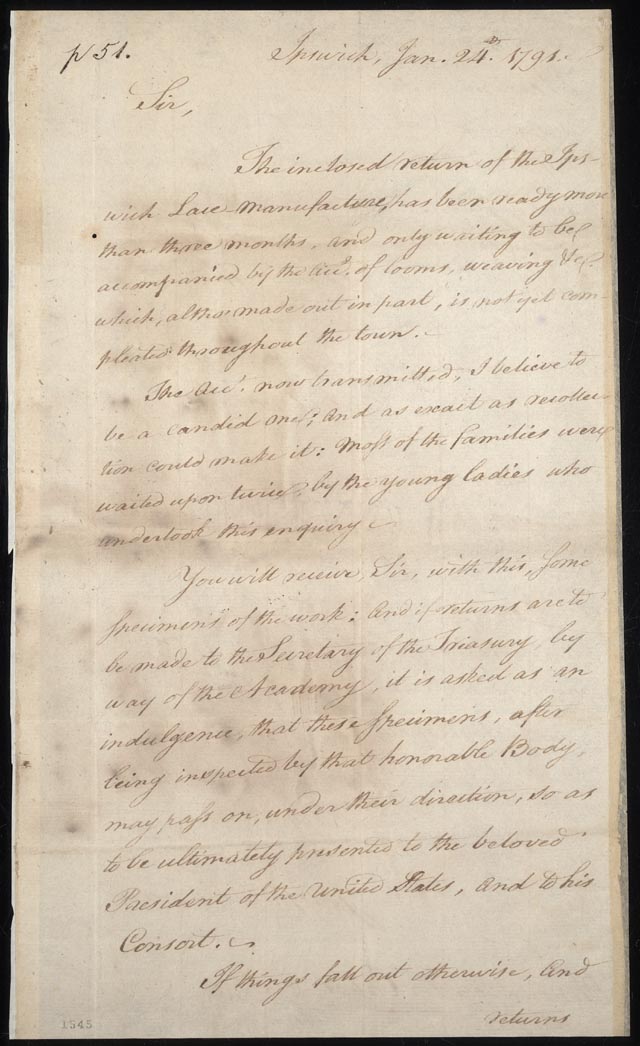So ready and brisk with her hands ... she earned by making lace, a silk dress for each of her daughters.
Caldwell Family Records
On August 31, 1654, John was the first Caldwell to arrive in Ipswich, Mass. He married Sarah Dillingham, a woman “of quality so graciously remembered by many generations of descendents” that they visited her resting place for years after her passing. This would hold true for many other female Caldwell family members known for their “remarkable presence” and “singular native and queenly dignity.” Sarah was “a woman of rare qualities of mind, of a generous nature, thoroughly democratic in her ideas, and her whole life was devoted to others. She was always ministering to the comfort of the poor and the sick.” (Caldwell Records)
The Caldwell women were not just proper society ladies, handing out alms to the less fortunate and attending sewing circles — they were inventive, industrious, highly skilled crafters. The Lace Makers are the most noted among these laborious eager beavers. The Ipswich Historical Society asserts that lacemaking was the first women’s industry in America, and members of the Caldwell family were among the forerunners.
Lacemaking came on the scene early,* and this painstaking craft provided financial assistance for families during wartime. More importantly, it empowered the local women, giving them a sense of purpose and community. House & Garden references an Aunt Mollie Caldwell who collected the Ipswich workers' lace once a week and took it to Boston by stagecoach; in exchange, she brought back French calico, sugar, tea, coffee, and other goods, including surreptitious little packages of highly desirable snuff.
It wasn't the lace makers alone who were not paid in currency. Town records as far back as 1640 permit that "No persons are compelled to pay future debts in cash, but corn, cattle, fish and other articles." Mrs. Caldwell not only disposed of the workers' lace, she was also clever enough to buy a bit from a peddler, prick off a pattern from it, and give it to one of the workers to reproduce.

In 1790, Alexander Hamilton urged the country to submit information on the manufacturing industry. Ipswich’s own Rev. Joseph Dana complied with a letter and 36 samples of lace collected from 1789 to 1790. Ipswich had 600 lace makers producing over 42,000 yards of bobbin lace within the year. Hamilton’s Report on Manufactures found "a Manufactory of Lace, upon a scale not very extensive, has been long memorable at Ipswich, in the State of Massachusetts." Dana used the new senator Cabot to entice Governor Trench Coxe to act as solicitor of Ipswich’s inventive women. Coxe brought the samples to a Philadelphia meeting.
Mary Boardman Caldwell was a part of this pioneer movement, as well as a leading maker and merchant of lace. Perhaps her talents in the craft of lacemaking were just as paramount as her networking skills. Mary was immersed in important social circles, and her marriage to Thomas Caldwell in Newburyport was a socioeconomic windfall, opening up a completely new territory of patrons. Some beautiful examples created by Lace Makers from Ipwsich and Old Newbury families: Elizabeth Heardsley and Sarah Greenleaf Boardman (Mrs. Offin Boardman) Benjamin Greenleaf Boardman
George Lethbridge Saunders, an artist from England, traveled to the States from 1851 to 1853. During his stay, many prominent families commissioned him to paint miniature portraits. His works “meticulously represented the details of lace, jewelry, and background” of the time. Here is an example:
Boston Intelligencer Ad March 32 1827
* The oldest sample of lace, credited to Anne Gower Endicott (1620), is housed in the Peabody Essex Museum. It is an example of drawn-work with very fine lace designs and some lettering, including Anne’s name. She learned her craft during her childhood in England. She obviously had a great love for beautiful lace, and this work demonstrates her talent and skill.Ironically, her husband John Endicott set forth a law in 1634 prohibiting the “wearing of silver, gold and silk laces, girdles, and hat bands.” (See my Fashion War in the Colonies in the Newburyport News for more info.)
The ministers and magistrates in Ipswich became ardent fashion police, but the public managed to work around the tight grip placed upon them. Occasionally a transgressor was taken before the court and fined, but to remain like Londoners, the spirit for finery and appearance won the day.
"The Lace Maker", Charles-Amable Lenoir
"The Lace Maker", Charles-Amable Lenoir
Sources
American Lace & Lace-makers Emily Noyes Vanderpoel, Amasa Stone Mather Memorial Publication Fund
Samplers and Tapestry Embroideries by Marcus Bourne Huish
A textile Lover's Diary
Salem in History
The Practical Book of Early American Arts and Crafts Harold Donaldson Eberlein, Abbot McClure, Mabel Foster Bainbridge
The practical book of American antiques, exclusive of furniture Da Capo Press, 1977
Publications of the Ipswich Historical Society, Issues 10-15
Ipswich in the Massachusetts Bay Colony Thomas Franklin Waters, Sarah Goodhue, John Wise
San Diego Union 1977 "She Laces with Dying Art"












Hello Melissa - I am currently researching the Caldwell and Day families of Ipswich, and stumbled upon your blog post. You mentioned "Caldwell family papers" - would you mind sharing your source? Would love to be able to review. Thank you so much.
ReplyDeleteLauren Rogers Mahieu
laurieanddogs@gmail.com
genejourneys.com